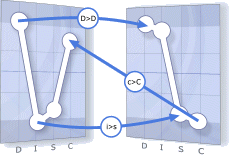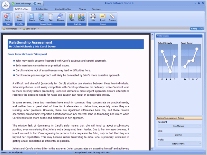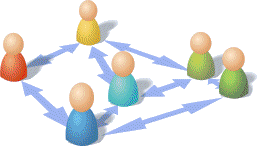How People Work TogetherDISC provides an excellent tool for describing a person's general behaviour, and even predicting how that person is likely to react in a range of circumstances. If we have DISC profiles for two different individuals, though, we can go a step further, and look at the ways those two people will interact with one another. That's the purpose of the Discus 'Relationship Assessment'. Given two sets of DISC profiles from your database, Discus will search for important factors in the relationship between the two. It can highlight important areas of synergy between the two, and also suggest likely causes of conflict.
Perspective is a critical issue when considering behavioural relationships: one person's view of the situation can often be quite different to the other's. So, each Discus Relationship Assessment is broken down into two separate sections, to look at the relationship from both points of view. In a team context, Discus also understands that the role of team leader can significantly affect the workings of a relationship. In this situation, the Relationship Assessment will automatically take account of the leader's role, and adapt its contents to describe any likely effects of that condition. Relationship Dynamics
Discus analyses relationships by looking for dynamics in the relations between the two profile. 'Dynamics' in this sense refer to the relationships between DISC factors on the two profile shapes. 
This diagram shows how dynamics work. For each combination of factors in a pair of DISC profiles, there's a corresponding dynamic, and by considering all these dynamics together, we can build a picture of the way a relationship works. Find out more |
DISC reference libraryBecome a DISC expert with our extensive online DISC reference library. Team building with DISCExplore the theory behind modelling teams using the DISC technique. |

Features
Reports
Branding
Software
Pricing
Training
Languages
Individual Reports
Agency Opportunities
DISC: A Layman's Guide
What is DISC?
Video: Introduction to DISC
DISC Profile Interpretations
DISC Factors
Team Building with DISC
History and Development of DISC
Personality Types
Applications: Putting DISC to Work
Validity and Reliability of DISC
Knowledge Base
(214) 613-3983
E-mail us
Skype us
Contact Details
(214) 613-3983
Features
Reports
Branding
Software
Pricing
Training
Languages
Individual Reports
Agency Opportunities
DISC: A Layman's Guide
What is DISC?
Video: Introduction to DISC
DISC Profile Interpretations
DISC Factors
Team Building with DISC
History and Development of DISC
Personality Types
Applications: Putting DISC to Work
Validity and Reliability of DISC
Knowledge Base
(214) 613-3983
E-mail us
Skype us
Contact Details
Factfile: analysing relationships
Choose which of our great value business packages is best for you, and you'll be up and running in just a few minutes.
| Send me an Information Pack | I would like to profile myself |
Arrange a callback
| Contact name | |
| Your contact number | |
| Your e-mail address | |
| Choose a day or days that suit you best |
Monday
Tuesday Wednesday Thursday Friday
Saturday
Sunday |
| Choose a time or period to suit you (your local time) |
About AxiomGuides |
Axiom Products |
About DISC |
Personal Profiles |
Support |



